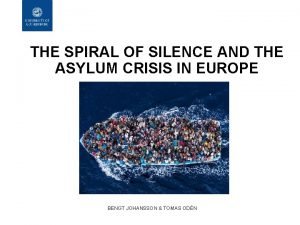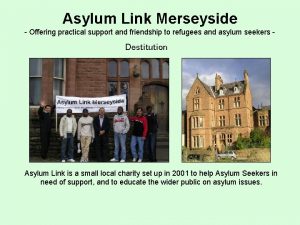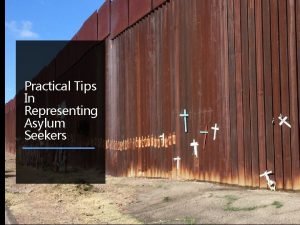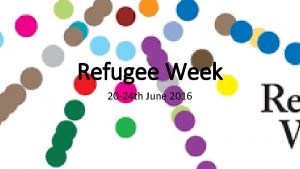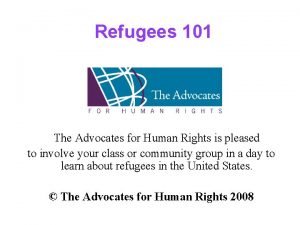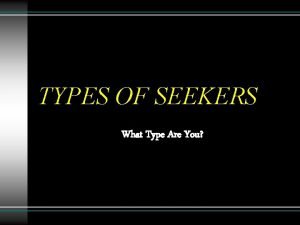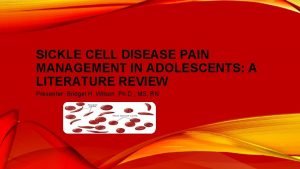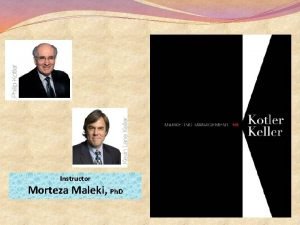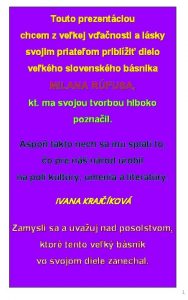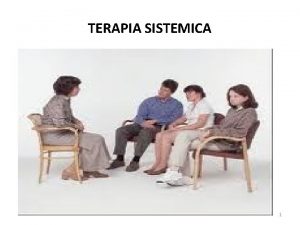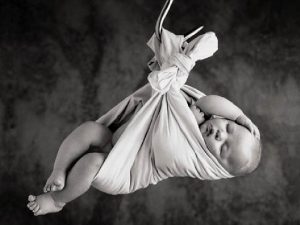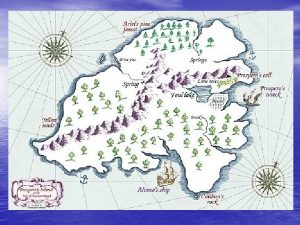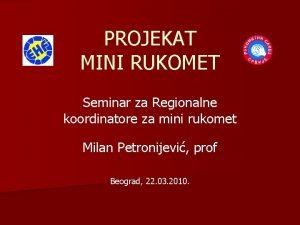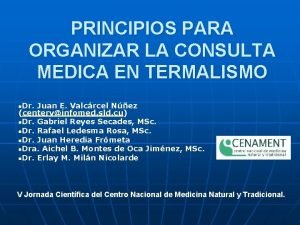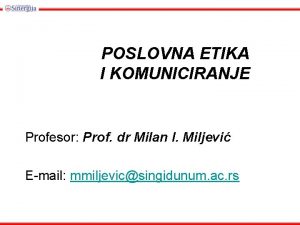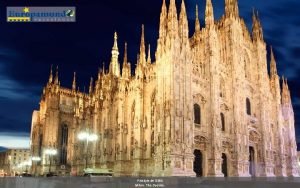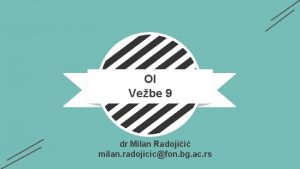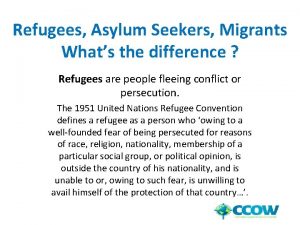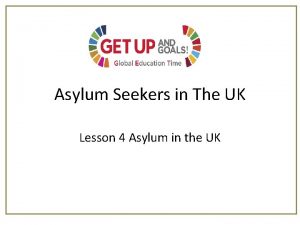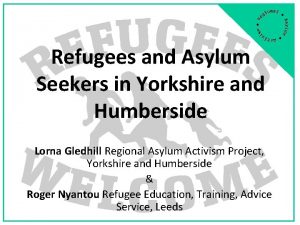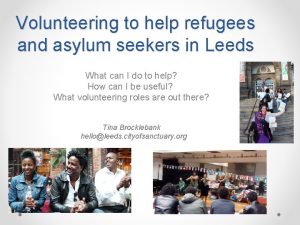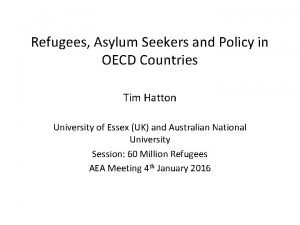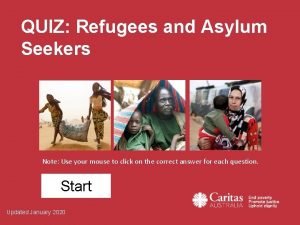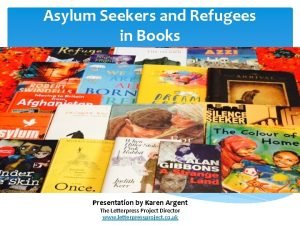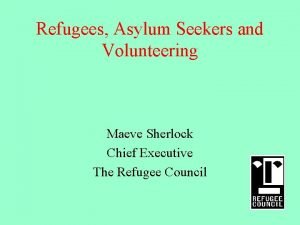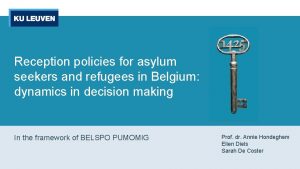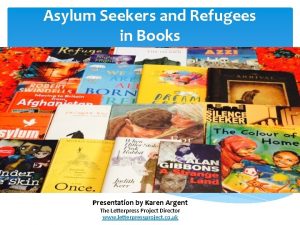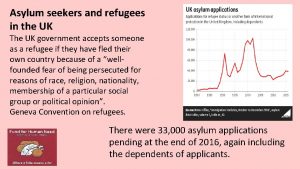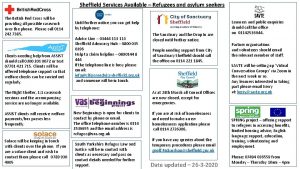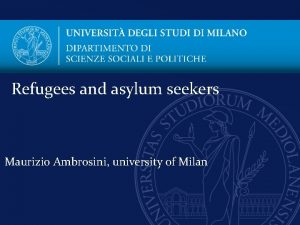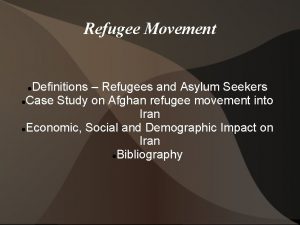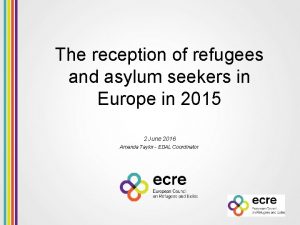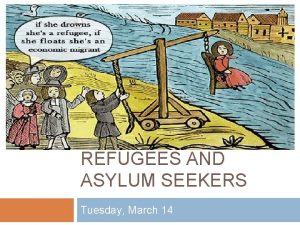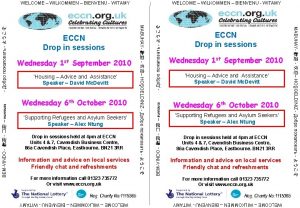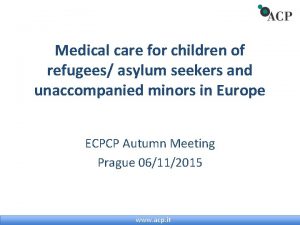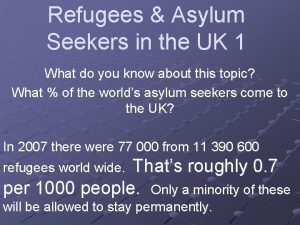INTEGRATION OF ASYLUM SEEKERS AND REFUGEES IN MILAN

































- Slides: 33

INTEGRATION OF ASYLUM SEEKERS AND REFUGEES IN MILAN Department for Social Emergencies, Rights and Inclusion Municipality of Milan – May 2018

City of Milan: Facts and figures • Overall surface: 181, 8 km 2 • Population: 1. 380. 873 (31/12/2017) • Foreign residents (no Italian nationality) : 266. 862 (31/12/2017)

Overview Main Nationalities

1 Reception system for asylum seekers and refugees – Facts and figures 2 From the asylum seekers hub Sammartini to CASC reception centre for asylum seekers and homeless 3 Perspectives 4 A national action Plan for integration

Reception system (L. 189/02) and Fundings European Union Ministry of Internal Affairs FIRST RECEPTION CENTRES GUARANTEED BY MILAN CITY COUNCIL (CAS) Emergency National funds provided by Ministry For Internal Affairs Prefettura di Milano (Local Ministry for Internal Affairs Office) Milan City Council 1. 100 accomodation places SPRAR – System for the Protection of Asylum Seekers and Refugees National Fund for asylum policies and services Otto per Mille funds Central Service (ANCI) – National Association of Italian Municipalities Milan City Council 422 accomodation places

2013 -2018: from “city of transit” to “city of destination” From October 2013 to April 2018 129. 500 migrants have been hosted in Milan in the centers managed by the Municipality (26. 200 were minors) 60, 000 52, 631 50, 000 40, 000 31, 855 30, 000 34, 202 20, 000 10, 000 8, 674 1, 316 1, 133 0 2013 (ott-dic) 2014 2015 2016 2017 2018 (Jan. Apr) Until 2016 98% of Non-Eu-nationals were transiting to a destination in another European city Today 99% of Non-Eu-nationals consider Milan as their final destination

The origins of the Syrian emergency The presence of Syrian nationals in the Municipality area started at the end of August 2013. The City of Milan Administration, with the help of voluntary organizations, provided at first social-sanitary assistance at the Central Railway Station and, subsequently, assumed a formal commitment to provide humanitarian assistance to Syrian nationals fleeing the war. On 18 October 2013, the City Council voted in favor of activating a reception service foreign people in transit through Milan, placed at the City Central Station. On the same day the City of Milan signed an Agreement with the Ministry of Internal Affairs local Office of Milan (Prefettura), valid until 31 December 2013. Given the characteristics of the flows coming in, it was necessary to continue the reception of foreign people in transit through Milan. Thus, the Agreement has been extended and currently it is confirmed until 31 December 2018 (1100 places).

Reception centres (CAS) under the agreement between the Municipality and the Prefettura Reception centres Organization managing the centre Casa Suraya – via Salerio Coop. Farsi Prossimo Via Pollini Ass. ne City Angels Via Pedroni Remar Italia onlus Via Andolfato Fond. ne Progetto Arca Flats in different locations Passepartout Via Mambretti Fond. ne Progetto Arca Via Beato Da Carcano Fond. ne l’Albero della Vita Via Sammartini 118 Fond. ne Progetto Arca Via Aldini 74 Fond. ne Progetto Arca

Graphical analysis of the phenomenon: daily and monthly flows (only guests of the centres under agreement with the Prefettura of Milan) Daily average of entrances on a monthly basis Daily average of presences on a monthly basis

Countries of origin Time trend Arrivals October 2013 – April 2018 Arrivals from Syria were prevalent until 2014; in 2018 Eritreans are the most represented community. Overall, there are 87 countries represented

Gender and age of the guests Time trend October 2013 – April 2018

Unaccompanied minors hosted in centres under the agreement (absolute and percentage trend October 2013 – April 2018) Unaccompanied minors % of unaccompanied minors over the total of minors hosted 2013 2014 2015 2016 2017 2018 13 944 1. 478 3. 315 1. 013 48 5, 4 8, 0 38, 0 54, 1 51, 0 26, 7 Since 2014 the percentage of unaccompanied minors hosted in centres under the agreement increased. These unaccompanied minors are mainly from Eritrea, Egypt and Afghanistan. 90% are males; around 50% are 17 years old and 20% are younger than 16.

Asylum seekers - Percentage trend of the migrants hosted in the centres under agreement

Focus on asylum seekers hosted in the centres of the Municipality of Milan - Percentage distribution per juridical status until 31/12/2017 Relocation; 0. 8 Residency permit for minors; 0, 1 Other; 0, 5 Permission denied; 5, 7 Dublin case; 5, 7 Asylum seeker pending the first appointment at the police headquarters; 9, 7 With international protection permission ; 14, 1 Asylum seeker pending the decision of the territorial commission; 6, 2 Asylum seekers permission pending territorial commission outcome; 8, 4 Asylum seekers permission pending the hearing in the territorial commision; 48, 3

Definitions and types of protection recognized in Italy - Foreign person in transit: a person who is fleeing from persecution or life danger - Asylum seeker: a fleeing person as described above, who is asking for protection to a country different from the country of his/her nationality - Refugee: an asylum seeker who obtains the full protection of a country different from the country of his nationality International protection types and permits of stay (permessi di soggiorno) recognized in Italy : - Refugee status: this is the full protection ex 1951 Convention, it is the ASYLUM recognised from a country to an asylum seeker (permit of stay for 5 years for ASYLUM) - Subsidiary protection to a person owning a real risk of suffering a serious harm – like death penalty, torture, serious threat to your person – in situation of armed conflicts (permit of stay for 5 years for SUBSIDIARY PROTECTION)

Humanitarian protection The humanitarian protection respects the principle of non refoulement declared in the 1951 Convenction, but it cannot be included in the international protection concept. It entitles to a permit of stay for 2 years for HUMANITARIAN REASONS in Italy - tipically for people with serius health problems or fleeing from countries affected by natural disasters, since it is not possible to repatriate them. • Asylum seekers receive a permit of stay as ASYLUM SEEKERS. In case of negative answer to their application, asylum seekers can appeal and they still receive a permit of stay as ASYLUM SEEKERS valid until the end of the trial (In this case the person is not entitled to work). • Every permit of stay entitles to dependent work (except the asylum seeker permit of stay, that entitles to work only 2 months after the application).

SPRAR - Protection System for Asylum Seekers and Refugees The Protection System for Asylum Seekers and Refugees was established in Italy by the law 189/2002 (the so – called Bossi Fini law), supported by the National Fund for Asylum Policies an Services, which places specific ordinary resources at the disposal of SPRAR activities. The Ministry of Internal Affairs acts as institutional guarantor, by establishing the Central Service, with responsibilities concerning information, promotion, consultancy, monitoring and technical support to the local authorities involved in the Protection System and by delegating the operational aspects to ANCI (National Association of Italian Municipalities). SPRAR receives at the moment 35. 869 asylum seekers and refugees in over 650 Italian municipalities. The Italian municipalities voluntarily apply to SPRAR and they offer «integrated reception» to beneficiaries, financed by the Ministry of Internal Affairs Office (and co-financed by the municipalities). The current agreement between the Ministry of Internal Affairs and the City of Milan will be in force until the 31 December 2019 (422 places).

SPRAR centers in Milan CENTER MANAGING ORGANIZATION via SAMMARTINI 75 Coop. Farsi Prossimo Via TESTI 302/A Coop. Farsi Prossimo via GORLINI 1 Coop. Farsi Prossimo FLATS in different locations Consorzio Farsi Prossimo, Comunità Progetto, Progetto Arca, Casa della Carità Via MONLUE‘ 87 LA GRANGIA Via STELLA 5 Fondazione Progetto Arca PENSIONATO via MONLUE‘ 65 Consorzio Farsi Prossimo Via BRAMBILLA 10 (guest with serious menthal health problems ) Casa della Carità

ACCOMMODATION AND INTEGRATION The System for the Protection of Asylum Seekers and Refugees GOALS Individual Projects to promote socioeconomic inclusion and integration THE SERVICES : ‒ MATERIAL ASSISTANCE Program: food, accommodation, pocket money, public transport card etc…) ‒ HEALTH, RECOVERY, MENTAL HEALTH AND WELLBEING: health screening, national health system registration, support, services and treatment for people with mental illness (acute psychiatric disorders, psychological and psychiatric support) ‒ SOCIAL INTEGRATION AND SUPPORT : Italian courses, school enrollment, sociocultural activities, sport activities, volunteering and orientation initiatives ‒ COUNSELLING AND SUPPORT FOR ORIENTATION ON THE LABOUR MARKET: competence assessment, vocational training, recognition of qualifications and competences, internship, job search advice ‒ HOUSING ASSISTANCE: housing related support to help asylum seekers and refugees live independent lives in their own homes

ACCOMMODATION AND INTEGRATION The System for the Protection of Asylum Seekers and Refugees DURATION OF THE PROGRAMME Temporary nature of reception (duration: 6 months because the main goal is to ensure autonomy) AVAILABLE RECEPTION PLACES ‒ From 2016 Milan City Council has provided 422 places (8 for people with mental disorders) ‒ From January 2018 to December 2019 - public call for tenders ‒ By 2018 Milan Municipality will ask for 1. 000 places PILOT PROJECTS ‒ Temporarily family housing of refugees ‒ RESETTLEMENT PROGRAM (resettlement of Syrian families coming from refugee camps in Lebanon and Turkey in cooperation with the Ministry for Internal Affairs, IOM e Unhcr)

Relocation Program in EU The Milan Model § Relocation program started in Milan in November 2015 as part of European Agenda on Migration: 415 asylum seekers were transferred from Milan to other European countries § Eligible Countries: Eritrea, Syria, Yemen, Bhutan, Bahamas, Qatar, United Arab Emirates and Bahrain The “relocation” program : Reception centres (CAS) data Until December 2016 50 relocation implemented 2017 425 relocation implemented

1 Reception system for asylum seekers and refugees – Facts and figures 2 From the asylum seeker hub Sammartini to CASC reception centre for asylum seekers and homeless 3 Perspectives 4 A national action Plan for integration

The new reception system Change in a day: 27 April 2017 § First aid and reception centre in Via Sammartini 118/120 has been closed. § Asylum seekers are now welcomed at Asylum Seeker and Homeless Resource Centre (CASC) in Via Ferrante Aporti 3 § Via Sammartini 118 is now a reception centre (CAS) hosting 75 people

Reception Centres (CAS) managed by Milan Municipality From 1 April 2017 to 1 April 2018 Access Admission

Asylum seekers assisted at the first aid and accommodation centre in Sammartini 1 st June 2017 – 30 th April 2018 93, 6% of assisted people are assisted as individuals. In absolute terms, the individuals are 3. 373 , families are 231 (overall number: 639 people)

Asylum Seeker and Homeless Resource Centre in via Ferrante Aporti June-17 Apr-18 Variation % TOTAL people registered 472 332 -29, 7 TOTAL people hosted 344 148 -57, 0 Family members (registered) 77 31 -59, 7 Individual (registered) 395 301 -23, 8 Unaccompanied MINORS (registered) 52 3 -94, 2 Single WOMEN (registered as individuals) 48 15 -68, 8 Accompanied MINORS (registered) 25 14 -44, 0

CASC VIA FERRANTE APORTI 3 April 2018 2017 N 176 Perc. 72, 1% N 1. 003 Perc. 37, 9% Persons seeking relocation 0 0, 0% 321 12, 1% Dubliners (people registered as asylum seekers in another European country) 26 10, 7% 245 9, 3% Persons in short stay (former persons in transit) 4 1, 6% 199 7, 5% Unaccompanied minors without papers 1 0, 4% 192 7, 3% Persons obtaining first appointment with the Immigration Office – Questura (checking only the administrative processing status at national level) 5 2, 0% 168 6, 3% Persons entitled to humanitarian protection 0 0, 0% 104 3, 9% Asylum seekers waiting to be recognized as refugee from the Territorial Commission 18 7, 4% 56 2, 1% Rejected applicants who can/have lodge/d an appeal 8 3, 3% 61 2, 3% Asylum seekers waiting for the decision of the Territorial Commission 2 0, 8% 59 2, 2% Persons entitled to “sussidiaria” protection 0 0, 0% 41 1, 5% Persons issued with an order to leave Italy 0 0, 0% 29 1, 1% Permit of stay for refugee status 0 0, 0% 30 1, 1% Asylum seekers waiting for the decision of the Territorial Commission 3 1, 2% 25 0, 9% 0 0 1 0 244 0, 0% 0, 4% 0, 0% 100% 17 3 48 47 2. 648 0, 6% 0, 1% 1, 8% 100% Persons seeking asylum Asylum seeker s waiting for relocation Permits of stay for children Other permits of stay Missing information Total

1 Reception system for asylum seekers and refugees – Facts and figures 2 From the asylum seeker hub Sammartini to CASC reception centre for asylum seekers and homeless 3 Perspectives 4 A national action Plan for integration

Perspectives: Reception of unaccompanied minors § Transfer of the Immigration Policy Unit into the new Department for Social Emergencies, Inclusion and Rights (January 2017) § Enforcing the System for the Protection of Asylum Seekers and Refugees (SPRAR) – More places for UAMS (150) in apartments and families § UAMS Resource Centre – First registration and assessment of the children § Implementation of legal custody (guardianship) and age assessment procedures together with Prefettura, Questura, Public Prosecutor’s Office the Juvenile Court (2017), Milan University

1 Reception system for asylum seekers and refugees – Facts and figures 2 From the asylum seeker hub Sammartini to CASC reception centre for asylum seekers and homeless 3 Perspectives 4 A national action Plan for integration

FIRST MIGRANT INTEGRATION ACTION PLAN OF NON-EU MIGRANTS Beneficiaries 74. 853 refugees (calculated on 31 August 2017) The Goals The Actions ‐ Fostering better understanding between migrants and the host communities – Active participation of non-Eu-nationals in economic, social and cultural life ‐ Working to promote inclusion and support the autonomy of asylum seekers and refugees ‐ Promoting the use of national and EU funds for reception, education, housing, health and social infrastructures for non-Eu-nationals. ‐ ‐ ‐ ‐ ‐ To promote dialogue between cultural and religious identities To make Italian language compulsory To develop innovative learning tools to increase skills and competences To promote easier access to health services To promote access to housing and to residence permit To simplify the procedures for refugee family reunion To provide more information and orientation to the services To prevent and combat discrimination To increase non-Eu-migrants participation and active citizenship Financial support available under European Structural Funds, the Resources European Social Fund (ESF) and AMIF national programmes

KEY QUALITIES FOR SUPPORT STATES TO RECEIVE REFUGEES IN A SAFE AND DIGNIFIED MANNER • Engaging more and more small and mid-size cities in receiving refugees in order to strong population and economic growth • Promoting refugee Entrepreneurship in the city • Building a sense of community in order to let refugees feel at home in the city offering emotional support (i. e. Places to pray like local mosques) • Implementing the leading role of the Municipality in coordinating the educational and health institutions to create a network of strategies and good practices at a local level, aiming at a further and deeper linguistic and scholastic integration • Offering good public transportation in order to open up more job opportunities (most of them have no access to cars or drivers’ licence)

KEY SUGGESTIONS FOR EU INSTITUTIONS AND UN SYSTEM TO SUPPORT LOCAL AUTHORITIES TO RECEIVE REFUGEES • Implementing the relocation program as a permanent measure for Southern European countries (10. 120 people relocated in 2 years) • Improving the resettlement program between UNHCR and the Ministry of Interior (1989 people in 2017, mainly Syrians) • Supporting humanitarian corridors, managed and self funded by non profit organizations (Community of Sant’Egidio, in collaboration with Federation of Evangelical Churches and Waldesian Church) through a permanent humanitarian visa release system.
 Worcester county asylum
Worcester county asylum The asylum
The asylum Asylum link merseyside
Asylum link merseyside Asylum case summary
Asylum case summary Bethpage asylum office
Bethpage asylum office Refugees brian bilston lesson
Refugees brian bilston lesson Mobility example ap human geography
Mobility example ap human geography Capoeira songbook
Capoeira songbook Refugees
Refugees Capoeira 4 refugees
Capoeira 4 refugees Types of seekers
Types of seekers Designing and managing integrated marketing channels
Designing and managing integrated marketing channels Seekers of yahweh ministries
Seekers of yahweh ministries Seekers great bear lake
Seekers great bear lake Treatise for the seekers of guidance
Treatise for the seekers of guidance Seeker's quorum chest
Seeker's quorum chest Vjfs
Vjfs Warning light
Warning light High value deal seekers
High value deal seekers Freedom seekers mc
Freedom seekers mc Three dimensions of corporate strategy
Three dimensions of corporate strategy Vertical integration
Vertical integration Simultaneous integration
Simultaneous integration Geton slovenija
Geton slovenija Geton trading forum
Geton trading forum Milan rufus modlitba za mier
Milan rufus modlitba za mier Geyman ciclo vital
Geyman ciclo vital Milan mrdak
Milan mrdak Rightful duke of milan
Rightful duke of milan Milan petronijevic rukomet
Milan petronijevic rukomet Nntiempo
Nntiempo Milan miljevic
Milan miljevic Milan paisajes
Milan paisajes Milan radojicic fon
Milan radojicic fon

